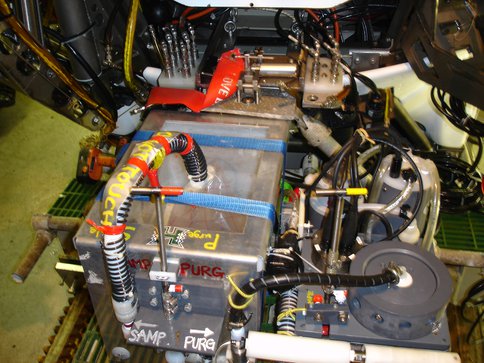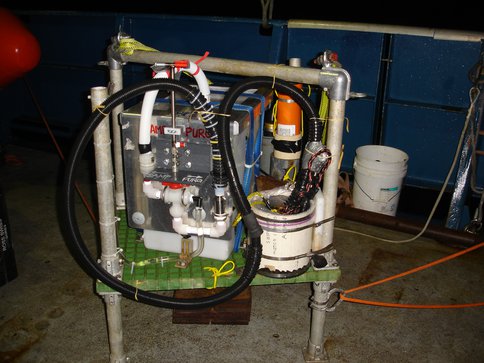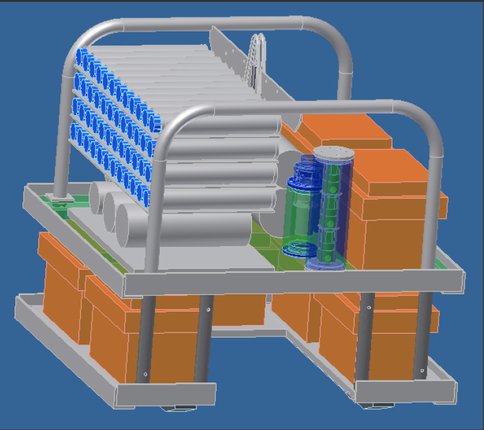2009 Annual Science Report
 University of Hawaii, Manoa
Reporting | JUL 2008 – AUG 2009
University of Hawaii, Manoa
Reporting | JUL 2008 – AUG 2009
Developing New Sampling System, Collection of Juan De Fuca Ridge Basement Fluids
Project Summary
Our Deep Biosphere project is designed to exploit the unprecedented opportunities provided by the new generation of long-term borehole- observatories installed on the flanks of the Juan de Fuca Ridge (JdFR) by the Integrated Ocean Drilling Program, to study the microbial geochemistry and ecology of the sediment-buried ocean basement. The Drill ship drills deep holes through the sediments into the underlying basaltic rocks and then installs a 'CORK’ observatory consisting of casings, fluid delivery lines with seafloor access-spigots, downhole instruments, and a top plug.
Project Progress
Our Deep Biosphere project is designed to exploit the unprecedented opportunities provided by the new generation of long-term borehole-CORK observatories installed on the flanks of the Juan de Fuca Ridge (JdFR) by the Integrated Ocean Drilling Program, to study the microbial geochemistry and ecology of the sediment-buried ocean basement.
Over this time period we 1) completed engineering/fabrication modifications to our in situ instrument sled (Figure 1) [The instrumentation sleds (e.g., the GeoMICROBE sled) allow for “in situ” (i.e., at the seafloor) geochemical analyses (e.g., electrochemistry) of the 30-65oC fluids that circulate within the sediment-buried basement, as well as the in situ filtration of fluids for ship and shore-based molecular biological, culture, biomass and geochemical procedures]; 2) developed several additional instruments (Figure 2 & 3) for efficient, non-contaminating sampling from CORK observatories; 3) accepted/hired 3 new project graduate students; 4) staged and successfully completed our second submersible research cruise to the Juan de Fuca Ridge flank CORK observatories; 5) presented two talks on the recent engineering developments as well as initial results from our previous (2008) project cruise, one at the Goldschmidt 2009 conference in Davos, Switzerland, and one at the “4th International Symposium on Chemosynthesis-Based Ecosystems -Hydrothermal Vents, Seeps and Other Reducing Habitats” held in Okinawa, Japan.
Mobile pump and fluid sampler carried on basket of submersible as submersible visits and connects to CORK observatory fluid lines. Allows collection of 60 liter volume of basement fluids into acid-cleaned bags.
The large volume fluid sampler is set up as independent elevator. It is carried to CORK by submersible where it is connected to mobile pump system (on submersible), filled with fluid, and then released to the surface as an free-floating unit.
Mechanical drawing of 4th generation of seafloor instrument sled designed for coupling to seafloor borehole CORK observatory; system includes integrated pump, valves, in-line fluid flow sensor, temperature probe, electrochemical analyzer, and 50-port in situ fluid filtration and collection sampler.
-
PROJECT INVESTIGATORS:
-
PROJECT MEMBERS:
Dave Copson
Collaborator
Brian Glazer
Collaborator
James Jolly
Collaborator
Michael Rappe
Collaborator
Sean Jungbluth
Graduate Student
Huei-Ting Lin
Graduate Student
Micheal Matzinger
Graduate Student
Ryan Matsumoto
Undergraduate Student
Natalie Hamada
Unspecified Role
-
RELATED OBJECTIVES:
Objective 3.2
Origins and evolution of functional biomolecules
Objective 3.3
Origins of energy transduction
Objective 4.1
Earth's early biosphere.
Objective 5.2
Co-evolution of microbial communities
Objective 5.3
Biochemical adaptation to extreme environments



